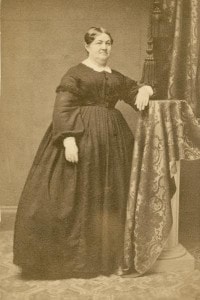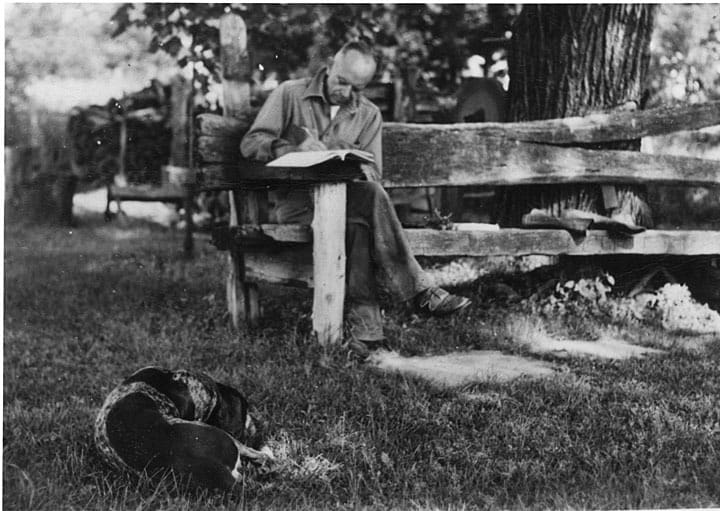This post is contributed by Ally Hrkac, our current Material Culture Summer Service Learner. Ally recently completed her B.S. in Secondary Education at UW-Madison and is working with Recollection Wisconsin this summer to develop online exhibits and educational resources.
This exhibit highlights multiple forms of memoirs written by Wisconsin residents. In viewing these accounts, we are doing more than merely reading a document – we are experiencing the life of another individual in a different time. For the people who wrote these letters, diaries, poems and journals, the act of writing brought personal comfort, solidarity, relief and preservation of connections to friends and family. For readers, these memoirs provide historical evidence and insight into the Wisconsin experience.
Settlers’ letters
Pioneers and European immigrants tracked their journeys to the state of Wisconsin by means of letters or diary entries. Some migrants recounted their travels in minute detail to share with family members or friends. After arriving in Wisconsin, settlers used letters and diaries to compare this New World with the Old, chronicling farming, weather and other elements of daily life. Many of these original documents have been transcribed or even translated by libraries, archives and historical societies, enabling contemporary Wisconsin residents to get a glimpse of the many cultures, languages, and heritages that have shaped our state.
“Now we do not want to go back even if we were the owners of the best farm in Moland [Norway]. This we know you cannot believe.”
–Gunliek Asmundson Bondal, letter home to siblings in Krago, Norway, 1854
(typed translation from the original Norwegian)
This letter depicts a Norwegian immigrant’s journey to the Koshkonong settlement in Dane County. Bondal also describes his family’s life in the New World and gives an account of farm life comparing prices, land conditions and interactions. Letters home like this one offer an impression of the land upon first settlement and the means by which settlers made a living. Bondal’s memoir writing tells readers that upon his settlement, he had become a successful farmer. His letter is characterized by minute details and quantitative measurements – the distance of the new railroad to Madison, the price of food and oxen, wages, and land acreage. Subsequently he starts comparing his new home with Norway, sharing news about his children, and asking about his family back in Norway.
“This home became very dear to me; I loved it, for I was happy there. The society, too, was pleasant.”
–Elizabeth Therese Baird, “Reminiscences of Life in Territorial Wisconsin,” 1900

Elizabeth Therese Baird documented her experiences as a young woman in early Green Bay in a memoir entitled “Reminiscences of Life in Territorial Wisconsin,” published by the Wisconsin Historical Society in 1900. Elizabeth had married Henry Baird in her home on Mackinac Island, and then together they made their way to Green Bay in 1824.
Baird documented her multiple encounters with Native Americans, with whom she and her husband often bartered. Baird lived a social life attending “impromptu” parties where everyone was fond of dancing, and she traveled to many Wisconsin settlements such as Janesville, Madison, and Milwaukee. In order to learn English, Baird took a job as a translator for her husband’s French-speaking clients of his law practice. In her personal memoir, Baird conveys her vast array of personal experiences in a way that show readers how Green Bay, Wisconsin became her home as she and her husband were shaping Wisconsin socially.
Soldiers’ stories
Wisconsin Civil War soldiers make history accessible to us through their letters, diary entries, poems, and records. Letter writing helped keep soldiers grounded and connected to the lives and families they left for the war. Perhaps a simple account of the day helped to ease any uncertainty or anxiety of the time. Whether a correspondence with a family member, a patriotic poem, or a short list of daily occurrences, the writings of Wisconsin soldiers shed light on a day in the life both before and after the war.
–Jules Francois, poem, Camp Utly, Racine, March 1862
(typed transcription)
A patriotic poem written by Jules Francois, a member of the 6th Wisconsin Light Artillery Battery, in 1862 shows both his national and Wisconsin pride. Francois composed this poem while in Camp Utly of Racine. This poetic form of memoir shows the inner thoughts of a soldier during his training before heading off to war.
“I have filled this day up by reading those letters and writing. It does me good to get letters from home and from my friends.”
–William Ault, letter home to wife and children in Green County, Wisconsin, 1865
(typed transcription by Raymond Buker, 1980)
On the other hand, some soldiers sought letter writing as a means of staying connected to the Wisconsin land to which they yearned to return. Private William Ault of Green Bay corresponded with his family to seek comfort and relief in familiarity and familial matters during the war. As Raymond Buker, grandson of Ault, compiled his grandfather’s letters, he remarked:
“It seems to me these letters have not only a personal interest to members of the family but also a general interest because they tell things not told in history books,– things as seen through the eyes of a private who, in this case, was an unwilling soldier whose main concern was to get back to his family and his farm in Wisconsin.”
Notes from the field
“Ornithological jaunts are made more fascinating by these unexpected events or finds which keep the bird man forever on the watch for something new.”
–Owen J. Gromme, field notes from Waukesha County, 1951
In order to better understand Wisconsin’s rich history of environmental studies, we can turn to the field notes, observations, sketches and studies of Owen J. Gromme – artist, author, biologist, botanist and zoologist. For decades he compiled organized notes of his findings and observations in his field composition journals. The entries, obtained from 1914 to 1989, demonstrate Gromme’s diligence, curiosity and passion for this field of study. Gromme, a Wisconsin native, utilized his observations and sharp senses to become an advocate for Wisconsin wildlife.
“The land ethic simply enlarges the boundaries of the community to include soils, waters, plants, and animals, or collectively: the land.”
–Aldo Leopold, manuscript for A Sand County Almanac
Another Wisconsin conservation thinker, Aldo Leopold, inspired fellow residents with his extensive writings on all aspects of conservationism, including his most famous work, A Sand County Almanac. Leopold’s impressive collection of correspondence, essays, reports, diaries, and memoranda shows that the foundations of his Almanac (among his other works) are his interest in nature and personal reflections about the world around him. Leopold derived the studies and theories that comprised A Sand County Almanac from the land that he studied in central Wisconsin.

The few examples mentioned above and the other collections linked below provide insight into the lives of individual Wisconsin residents and the times and places in which they lived. These memoirs also show us that all kinds of writing – letters, diaries, notes, etc. – hold important roles in our lives. In the past as well as today, people write in order to capture the passion in professional work, connect with friends and family members, think through personal issues and concerns, and preserve memories and experiences for future generations. Why do you write? Share in the comments section below.
Sources
The quotes and materials in this exhibit come from the following digital collections. Follow the links to browse and search the full collections.
- Aldo Leopold Archives, Aldo Leopold Foundation
- Owen J. Gromme Field Notes 1914-1989, Edgewood College Library
- Turning Points in Wisconsin History, Wisconsin Historical Society
- Wisconsin Goes to War: Our Civil War Experience, Wisconsin Historical Society. Part of the State of Wisconsin Collection from University of Wisconsin Digital Collections.
- Wisconsin Pioneer Experience, Council of University of Wisconsin Libraries and Wisconsin Historical Society. Part of the State of Wisconsin Collection from UWDC.
Discover more Wisconsin memoirs
These digital collections also feature letters, diaries, and other original writings by Wisconsin residents.
- Ada James Papers and Correspondence 1915-1918, Wisconsin Historical Society
–Correspondence documenting James’s role in the suffrage movement in the last years leading up to the passage of the 19th amendment. - Baird Manuscript Collection, Wisconsin Historical Society
–Papers of Henry and Elizabeth Baird, 1798-1937. - Brown County War History Committee Collection, Neville Public Museum of Brown County
–Letters home from Brown County soldiers who served in World War I. - Deleglise Documents, Langlade County Historical Society
–Letters written to family members by Francis Deleglise, founder of the city of Antigo, during his service in the Civil War. - Gartner Diaries, St. Norbert College
–Diaries of the travels of Austrian Norbertine priest Father Maximilian Gartner of Wilten Abbey in Austria, who arrived in Wisconsin in 1846. - Rufus and Charles King Collection, Carroll University Library
–Letters and diaries documenting Rufus King’s service in the Civil War and Charles King’s involvement in the Indian Wars of the American West and the Philippines.





You must be logged in to post a comment.